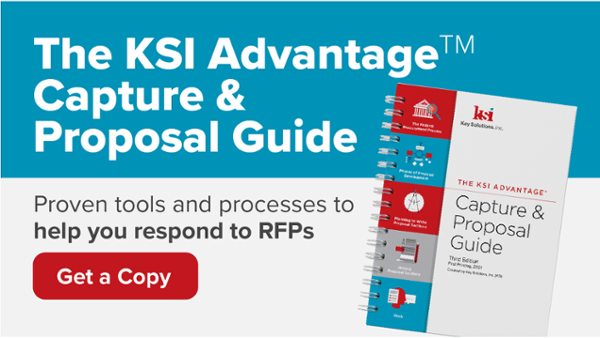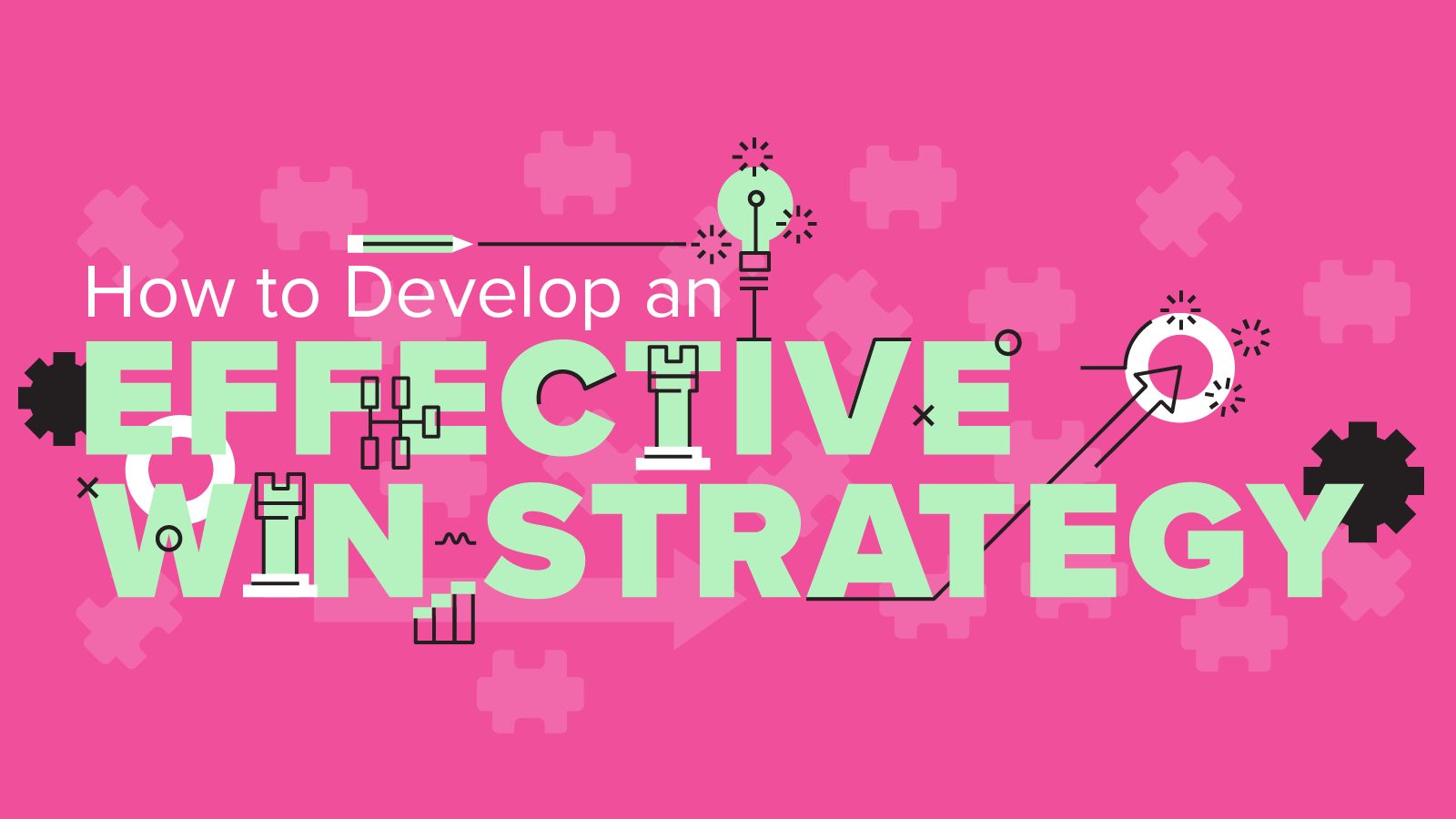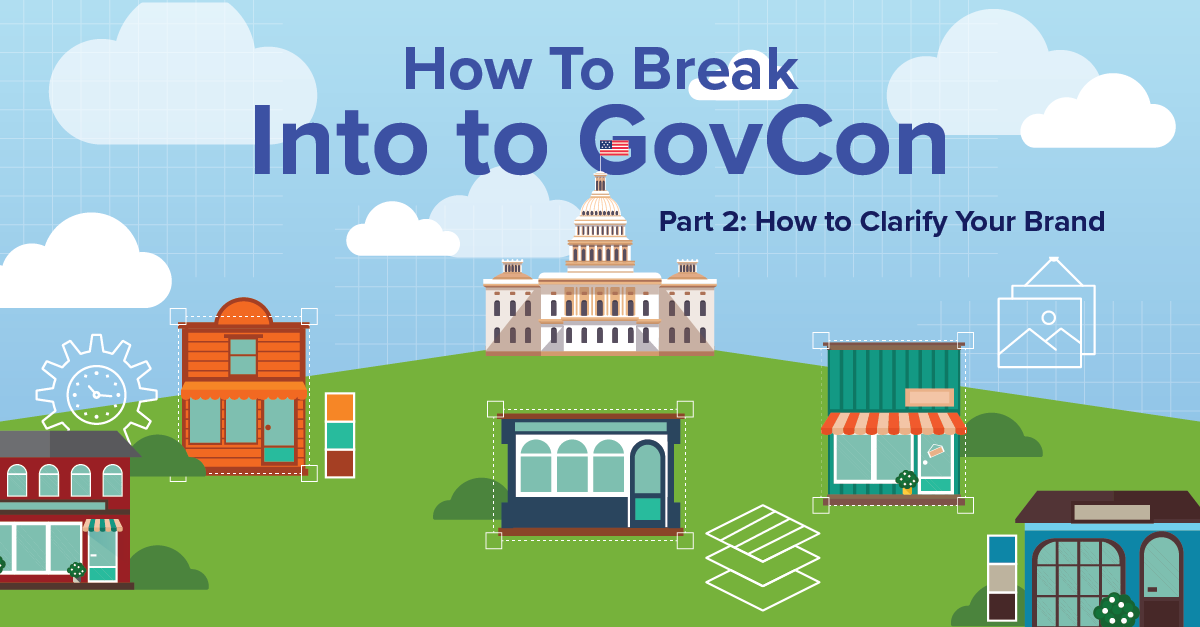
According to Bloomberg Government, Federal contract spending in fiscal year 2020 hit the highest amount on record—$681 billion.
Civilian agency contract spending also hit a record high of $228 billion, a 17% increase from 2019. And small businesses won $144 billion (22%) of government spending in fiscal year 2020.
For small businesses that want to work with the government, these numbers are exciting and enticing. The money is there, and the government needs to spend it. Take caution, however. While it's true that the U.S. federal government is the world's largest buyer, breaking into government contracting (GovCon)—much less succeeding and winning work—requires strategy, persistence, and patience.
There are rules and regulations to doing business with the government. The process is rarely quick, and success can feel unreachable and even elusive at times. But take heart.
In this small business series, we will tackle how to break into government contracting by unpacking the Six C's to Success. We will discuss the most common mistakes small businesses often make while navigating the federal marketplace and provide tips, resources, and next steps you can take to break in—and stay in—the world of GovCon.
The series posts include:
- Introduction (Know Your Basics)
- Clarify Your Brand
- Confirm Your Prospects
- Connect with Customers
- Conquer Roadblocks
- Capture Opportunities
- Compete to Win
In this article, we delve into the first C to success—Clarifying Your Brand. This post contains exercises and resources to help businesses define who they are, what they do, and how they stand out from their competitors.

Clarify Your Brand—the first step to succeed in GovCon
The first article of this series discussed the basics of federal contracting. Now, we focus on the first C to success in GovCon—Clarify Your Brand. No one can be all things to all people. Figuring out what customers want and then trying to develop a thriving business around that won't work.
Sustainable, long-term success in any business requires you to first know who you are, what you do well, and where you fit in the market. You must clarify your brand. With this depth of understanding, you can better focus and strategize for growth.
1. Know Who You Are
You are in business for a reason. There is something about your business that is unique to you and fills a specific need or want. To help determine what that is, it's helpful to clearly define your mission, vision, and values, as well as perform an internal Strengths, Weaknesses, Opportunities, and Threats (SWOT) analysis.
- Vision – A vision statement is your big picture objective and answers what kind of impact you want your business to have on the world.
- Mission – A mission statement answers "how" you will achieve your vision and explains why your company exists.
- Values – According to CultureSync, "Our core values inform every action that we take." They are the principles by which we make decisions and answer the question: "What matters most to you?" Use the link to identify your company's core values.
- SWOT Analysis – What are your company's strengths and weaknesses?
Now that you have a clear idea of who you are, what you do, and why you do it, you need to ask yourself if working with the federal government will take your business in the direction you want it to go. Answering "No" to this question is an acceptable and respectable decision if pursuing government contracts does not align with the strategic plan for your company.
After all, it doesn't make sense to spend precious time and resources chasing work that could detract from or weaken your main line of business. If your answer is "Yes", however, and you think doing business with the government is worth the investment of time and money, then move on to step two.
2. Know Your Sweet Spot
Developing a unique level of expertise in areas that matter most to your customers helps ensure that when it comes time to buy, they turn to you. Continuing this approach over time leads to business growth. In contrast, companies that have nothing unique to set them apart from their competitors are reduced to competing on price alone—cutting prices in the hope of wooing the customer. Unfortunately, this strategy isn't the best for sustained growth since other businesses do the same thing, making profit margins smaller and smaller.
Harvard Business Review published an article by C.K. Prahalad and Gary Hamel that explained how identifying, developing, and leveraging your company's core competencies make growth possible. Ask yourself the following questions to help determine your core competencies:
- What do you do particularly well? In other words, what product or service do you provide that people want so much it keeps them coming back to you?
- What makes you different in how you provide that product or service? In essence, why do they keep coming back to you for what they need?
- Why should an agency buy from you rather than a competitor, or not choose to do the work themselves?
- What problem of theirs do you solve?
- What added value do you bring?
- How can your company help the government meet its goals, objectives, and mission?
- What parts of your company's products or services have appealed to previous customers?
- Is there a niche area where you can target your products or services?
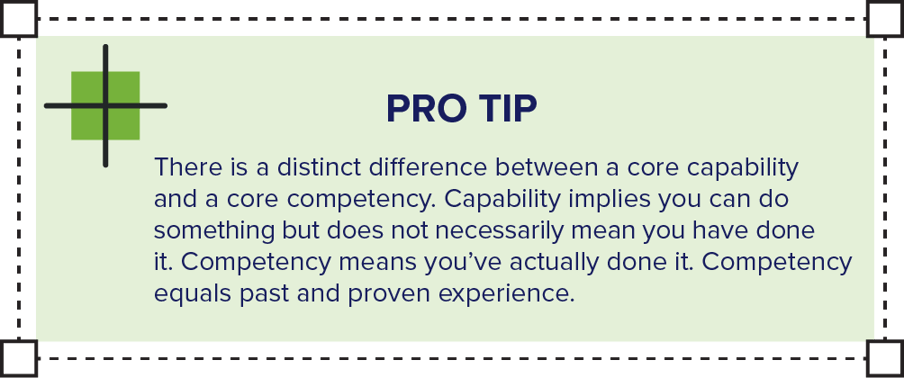
Once you have identified your core competencies, assess their effectiveness using the following criteria by Prahalad and Hamel:
- Relevance – The competency must give your customer something that compels them to choose your product or service over someone else's. If it doesn't, then it has no impact on your competitive position and is not a core competency.
- The difficulty of imitation – The competency must be difficult to imitate. This enables you to provide products or services that beat your competition. As you continually improve on these capabilities, you will maintain your competitive edge.
- The breadth of application – The competency should avail you to additional markets. If it only provides entry into a few small, niche markets, that will not be enough to sustain long-term and significant growth.
Keep in mind that government buyers are risk-averse. They would rather do business with those who have proven experience providing the services or products they need. As stated in the book, Government Contracts Made Easier,
“When a government buyer (or prime contractor) says ‘Tell me about what you do,’ what they’re really asking is, ‘Show me how you’ve solved a problem a lot like mine, for someone who looks a lot like me, yesterday afternoon.’
Past experience matters. However, if you don't yet have past experience providing the services or products your prospective buyers want, there are things you can do like teaming or subcontracting, which we will discuss in future articles when we examine how to capture opportunities and compete to win.
3. Know Where You Fit in the Federal Marketplace
There are thousands of companies competing for work in the federal marketplace, and many of them seem to offer very similar products and services. In fact, very few businesses are truly unique.
Consider for instance, how many contractor websites you see that describe their company’s ability to deliver “mission-critical services with the right people, the right way, at the right time?”
It might sound catchy and compelling at first, but drill down a little deeper, and you soon realize that it's nothing more than puffery that really doesn't deliver anything. It's difficult enough to sustain and grow a business. It becomes even harder with undifferentiated offerings and unsubstantiated claims. You must know who you are, what you do well, and what makes you stand out. Until you identify what sets your company apart from the masses, you cannot effectively steer your sales efforts. Hence the need to pinpoint your unique value proposition (UVP).
Your UVP is a concise message that describes the benefits you offer, how you solve your customer's problem, and what distinguishes you from your competitors. Knowing your sweet spot (Step #2 above) will help you develop a strong UVP. Ultimately, your UVP is the reason why people buy from you. It's your promise to deliver value based on your customer's perceptions of what matters most to them.
Think of your UVP as an equation— cost versus benefits—that is automatically and subconsciously assessed by your customers whenever they encounter your brand. If the perceived benefits outweigh the perceived costs, the more likely it is that your prospects will buy into and support your brand. So how do you discover your UVP?
Understand Your Customer
Ask yourself the following questions about your current and potential customers:
- What do they really want and need?
- What are the outcomes they want to accomplish?
- What are they buying and why?
- What motivates their buying decisions?
- What do they perceive as valuable about those products or services?
- What solution can you offer that is the best fit for this customer?
- Why are you the best company to meet this need for this customer?
Knowing the answers to these questions will serve you well when you connect and engage with your customers, make bid/no-bid decisions, and write proposals in response to solicitations. We will revisit the UVP concept in future articles when we examine how to confirm prospects, connect with customers, capture opportunities, and compete to win.
Know Your Competition
Now, conduct a SWOT analysis to assess your competitors. Based on what you learned about your customer, how well are your competitors meeting the criteria? What are their strengths, and what are their weaknesses? What can they offer the customer that you can't?
Leverage Your Strengths
Using the SWOT analysis you completed in Step 1, identify your company's strengths and then determine how well your products and services meet those same criteria. Also consider that some companies focus on one, or a combination of the following factors to differentiate their brand:
- Product/service features (what you offer)
- Product/service delivery (how you deliver/perform what you offer)
- Price
Last, look at where your competition is weak and compare that against your strengths. Identify areas where your strengths can fill the customer's need or solve their problem in ways your competition can't. Remember that your UVP needs to matter to your customer. It makes no sense to be the best in your industry at something your customer sees no value in. Use the information you uncovered during this analysis to develop your UVP.
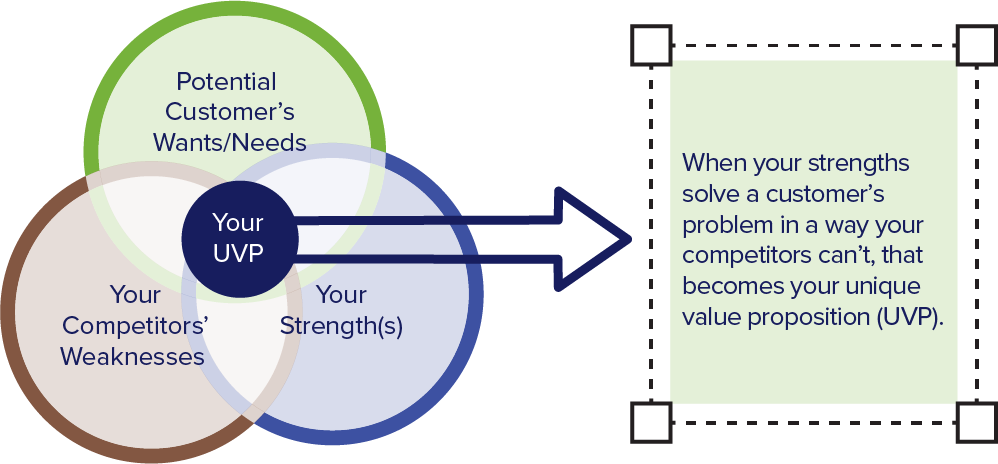
Conclusion
The federal government reserves billions of dollars each year for government contracting with small businesses. Given enough time and planning, it is possible to break into the federal market and succeed if you determine it's the right fit for you. Building on the process of clarifying your mission, vision, and values; defining your sweet spot; and determining where you fit in the market, your next step is to identify your most suitable business prospects.
In the next article, you will use the information gained from the exercises in this one to dig deeper into How to Break into GovCon as we examine the next C to Success—Confirm Your Prospects.
Helpful Links and Resources for Small Businesses
There are many resources available to help grow your business and succeed in government contracting. Listed below are organizations that offer free counseling and training assistance to small businesses as well as other resources:
- Association of Procurement Technical Assistance Centers (APTAC): Nationwide network of dedicated procurement professionals working to help local businesses compete successfully in the government
- SBA: Provides free counseling and contracting assistance to small businesses
- Virginia PTAC: Helps Virginia businesses identify, compete for, and win government contracts.
- How to Get Started in Government Contracting with Neil McDonnell
- Offices of Small and Disadvantaged Business Utilization (OSDBU): These offices are run by each government agency to help small businesses learn how to work with that specific agency
- Veteran Institute for Procurement: The VIP is a training program that teaches owners, principals, and C-level executives of veteran-owned small businesses (VOSB) how to win and manage government contracts. Check out our Empowering Veterans in GovCon podcast interview with the VIP.
- Minority Business Development Agency: The U.S. Department of Commerce, Minority Business Development Agency (MBDA) is a federal agency solely dedicated to the growth and global competitiveness of minority business enterprises.
- The KSI Advantage Capture & Proposal Guide: Learn about the federal procurement process, the proposal lifecycle, and proposal writing techniques.
ARTICLE SOURCES:
Bradt, Judy. Government Contracts Made Easier. Middletown, DE: Summit Insight, 2019.
CultureSync. (No Date). Mountains and Valleys Exercise. https://culturesync.net/tools/mountains-and-valleys/. Accessed 18 Feb. 2021 from CultureSync.
Entrepreneur. (No Date). Unique Selling Proposition (USP). Accessed 17 Feb. 2021, from Entrepreneur: http://www.entrepreneur.com/encyclopedia/unique-selling-proposition-usp.
Goward, Chris. How to Create an Awesome Value Proposition. Widerfunnel, 27, Aug. 2020: https://www.widerfunnel.com/blog/how-to-create-an-awesome-value-proposition. Accessed 17 Feb. 2021.
Keller, Kevin Lane; Sternthal, Brian; and Tybout, Alice M. Three Questions You Need to Ask About Your Brand. Harvard Business Review, Sept. 2020, https://hbr.org/2002/09/three-questions-you-need-to-ask-about-your-brand. Accessed 17 Feb. 2021.
MindTools. (No Date). Core Competencies Analysis Building Sustainable Competitive Advantage, from MindTools: https://www.mindtools.com/pages/main/newMN_STR.htm#Competitive%20Advantage. Accessed 17 Feb. 2021
Snyder, Daniel. Federal Contract Spending: Five Trends in Five Charts. Bloomberg Government, 05 Jan. 2021, https://about.bgov.com/news/federal-contract-spending-five-trends-in-five-charts-2. Accessed 14 Feb, 2021.



